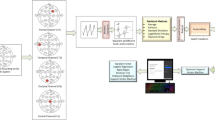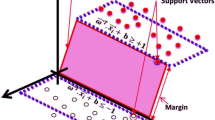Abstract
In this paper, we present a method for electrocardiogram beat based on multi swarm optimization and radial basis function neural network. ECG is a non-surgical method for measuring and recording the electrical activity of the heart and on many occasions, an experienced cardiologist may not be available on the patient’s site. Therefore, a type of automated ECG analysis is required for the patient to take the electrocardiogram by a general practitioner or paramedical team attending the patient’s location. There is a need for automated ECG analysis. Finally, this paper gives the best analysis methodology for the automated analysis of multi-channel ECG signals. Diagnosis may be affected by the presence of artifacts and noise in multi-channel ECG signals. Some researchers calculated dynamic cutoff frequency parameter from noisy ECG signals to remove noise using the neural network method of Radial Basis function with particle swarm improvement method (RBFNN-PSO). But PSO only has Swarm and it takes a lot of time to give a response. To overcome these limitations, an improved version of the RBFNN-PSO algorithm called Radial Basis Function Neural Network with Multi Swarm Optimization (RBFNN-MSO) has been proposed. Finally, the cutoff frequency parameter is determined by the RBFNN-MSO methodology that is applied to digital low-frequency filters for impulse response (FIR). The next step after removing noise from multi-channel ECG signals is the feature extraction and reduction process. 24 features of the patient’s multi-channel ECG signals are extracted. The next part of the research is divided into two steps. The first step is whether or not the patient’s ECG signals are affected. The vector machine is supported with particle swarm improvement (SVM-PSO) and another way is to support the vector machine with multi swarm improvement (SVM-MSO) to detect ECG signals of the affected patient or not. Finally, SVM-MSO offers greater accuracy compared to SVM-PSO. When compared to all other existing architecture results, they used the rating with 86% of all the test accuracy. But in this paper, our proposed work has 90% overall in different situations. In another point of view also,our proposed work has proven that average accuracy is over 85% even then train data set is small.










Similar content being viewed by others
References
Ardjani, F., Sadouni, K., & Benyettou, M. (2010). Optimization of svm multiclass by particle swarm (pso-svm). In 2010 2nd International Workshop on Database Technology and Applications, pp. 1–4. IEEE
Blackwell, T., & Branke, J. (2006). Multiswarms, exclusion, and anti-convergence in dynamic environments. IEEE Transactions on Evolutionary Computation, 10(4), 459–472.
Chandrakar, B., Yadav, O., & Chandra, V. (2013). A survey of noise removal techniques for ecg signals. International Journal of Advanced Research in Computer and Communication Engineering, 2(3), 1354–1357.
Chinchkhede, K., Yadav, G. S., Hirekhan, S., & Solanke, D. (2011). On the implementation of fir filter with various windows for enhancement of ecg signal. International Journal of Engineering Science and Technology (IJEST), 3(3), 2031–2040.
Farrell, R. M., & Rowlandson, G. I. (2006). The effects of noise on computerized electrocardiogram measurements. Journal of Electrocardiology, 39(4), S165–S173.
Garšva, G., & Danenas, P. (2014). Particle swarm optimization for linear support vector machines based classifier selection. Nonlinear Analysis: Modelling and Control, 19(1), 26–42.
Gupta, K. O., & Chatur, P. (2012). Ecg signal analysis and classification using data mining and artificial neural networks, 1,
Islam, M., Tangim, G., Ahammad, T., Khondokar, M., et al. (2012). Study and analysis of ecg signal using matlab & labview as effective tools. International Journal of Computer and Electrical Engineering, 4(3), 404.
Jyothi, G.N., Sanapala, K. & Vijayalakshmi, A. (2020). Asic implementation of distributed arithmetic based fir filter using rns for high speed dsp systems. International Journal of Speech Technology pp. 1–6.
Kennedy, J., & Eberhart, R. (1995). Particle swarm optimization. In Proceedings of ICNN’95-International Conference on Neural Networks (Vol. 4, pp. 1942–1948). IEEE
Khazaee, A., & Zadeh, A. (2014). Ecg beat classification using particle swarm optimization and support vector machine. Frontiers of Computer Science, 8(2), 217–231.
Kohli, N., & Verma, N. K. (2011). Arrhythmia classification using svm with selected features. International Journal of Engineering, Science and Technology, 3(8), 122–131.
Li, J., Xiao, X.: Multi-swarm and multi-best particle swarm optimization algorithm. In IEEE 2008 7th World Congress on Intelligent Control and Automation, pp. 6281–6286. (2008)
Moein, S. (2010). Fir cutoff frequency calculating for ecg signal noise removing using artificial neural network. In International Conference in Swarm Intelligence (pp. 124–131). Springer.
Moein, S., & Logeswaran, R. (2012). Intelligent ecg signal noise removal using psonn. International Journal of Computer Applications, 45(6), 9–17.
Moein, S., Logeswaran, R., Subari, K.S. (2012). An automated intelligent approach for ecg signal noise removal. International Journal of Computer Science.
Nasiri, J.A., Naghibzadeh, M., Yazdi, H.S., Naghibzadeh, B. (2009). Ecg arrhythmia classification with support vector machines and genetic algorithm. In: 2009 Third UKSim European Symposium on Computer Modeling and Simulation, pp. 187–192. IEEE
Omran, M., Engelbrecht, A. P., & Salman, A. (2005). Particle swarm optimization method for image clustering. International Journal of Pattern Recognition and Artificial Intelligence, 19(03), 297–321.
Srinivasulu, M., & Reddy, K. C. (2014). Novel method to find the parameter for noise removal from multi-channel ecg waveforms. International Journal of Research in Engineering and Technology, 3(2), 395–401.
Tu, C. J., Chuang, L. Y., Chang, J. Y., Yang, C. H., et al. (2007). Feature selection using pso-svm. International Journal of Computer Science,.
Zhao, S.Z., Liang, J.J., Suganthan, P.N., & Tasgetiren, M.F. (2008). Dynamic multi-swarm particle swarm optimizer with local search for large scale global optimization. In 2008 IEEE Congress on Evolutionary Computation (IEEE World Congress on Computational Intelligence) (pp. 3845–3852). IEEE
Author information
Authors and Affiliations
Corresponding author
Additional information
Publisher's note
Springer Nature remains neutral with regard to jurisdictional claims in published maps and institutional affiliations.
Rights and permissions
About this article
Cite this article
Srinivasulu, M. Multi-lead ECG signal analysis using RBFNN-MSO algorithm. Int J Speech Technol 24, 341–350 (2021). https://doi.org/10.1007/s10772-021-09799-y
Received:
Accepted:
Published:
Issue Date:
DOI: https://doi.org/10.1007/s10772-021-09799-y




